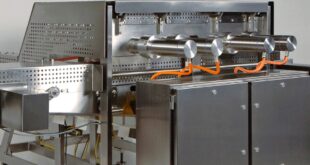Laser sintering printers can produce simple or complex parts.
In an installation space of 220 x 170 x3 00mm, for example, 5,000 plain bearings with an inner diameter of 10mm can be produced within 30 hours.
Laser sintering ensures that igus can offer the components not only fast, but also with a higher strength and more cost-effectively than using the FDM process.
High costs, such as the production of injection moulding tools, are eliminated and many design iterations can be made easily on the computer. In conventional injection moulding, on the other hand, entire moulds need to be retooled. In addition, there is no price difference between complex and simple shapes.
HERE we take a look behind the scenes at igus to find out how the company’s SLS 3D printers work.In this process, the wear-resistant laser sintering material iglidur I3, specially developed by igus, is applied on the entire working platform and the first layer is melted.
After each work step, the plate is lowered by 0.1mm and a new layer applied.
When the print run is complete, the printed parts are separated from the powder and finished off with an air blasting machine to ensure every particle is removed.
 Engineer News Network The ultimate online news and information resource for today’s engineer
Engineer News Network The ultimate online news and information resource for today’s engineer





